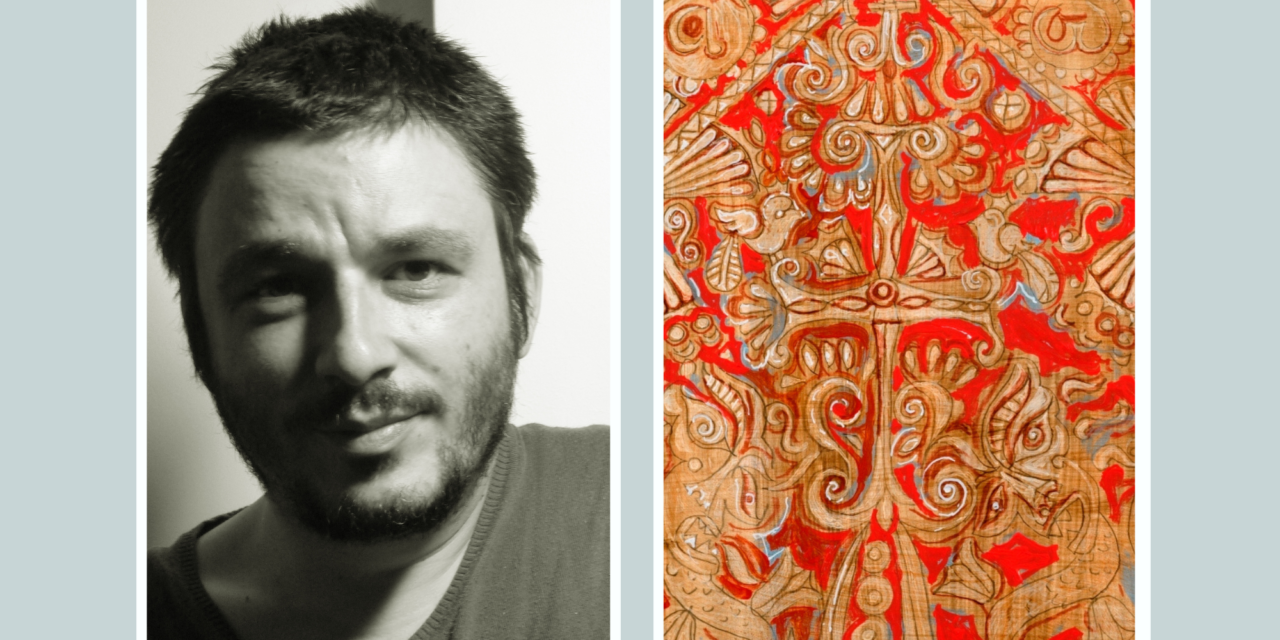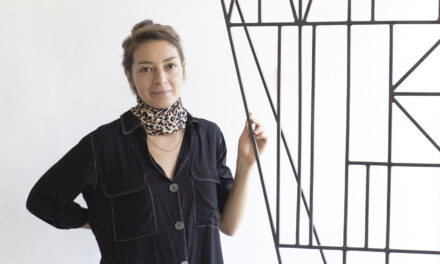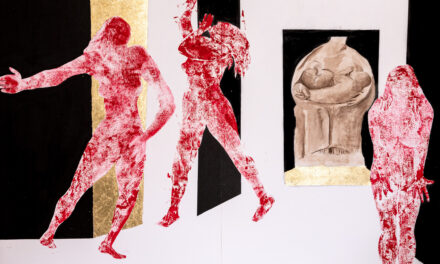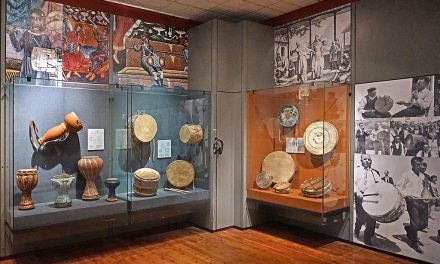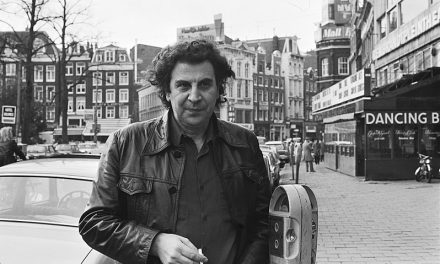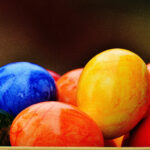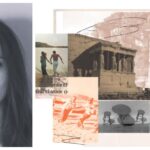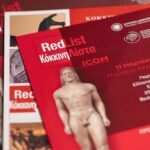Alekos Kyrarinis is a contemporary Greek painter, deeply inspired by pre-Christian symbolism, Byzantine iconography, Greek folk art, and modernism. His artistic style resonates with a deep engagement with cultural heritage and spirituality.
Sacred figures (saints, angels, demons), dragons and birds reflect his commitment to exploring religious themes, the eternal duality between good and evil and man’s struggle to overcome his weaknesses. His art suggests an inner dialogue about human existence, revealing his deeply personal and philosophical perspective.

Kyrarinis’ visual idiom feels both timeless and modern as he skillfully weaves together traditional techniques, such as egg tempera on wood, and contemporary aesthetics. His work is infused with spirituality, incorporating decorative motifs, symbolic patterns, and delicate lines that create a sense of movement and rhythm. Kyrarinis explores universal themes of conflict and redemption, utilizing a visual language that transcends specific religious contexts, emphasizing the spiritual intensity of the depicted struggles.
Alekos Kyrarinis was born in 1976 in Athens and raised on the island of Tinos. From the age of eleven, he apprenticed with his father, Yiannis Kyrarinis, a marble sculptor and in 1997 he was admitted to the Athens School of Fine Arts. He studied under Yiannis Psychopedis and graduated in 2003. His work has been shown in 21 solo exhibitions in Greece, Spain, Belgium and France. He has also participated in several group exhibitions in Italy, Belgium, Luxembourg, Austria, Poland, Romania, France and Spain.

Alekos Kyrarinis speaks to Greek News Agenda* about his artistic approach and philosophical perspectives.
As an artist, you came up with your personal visual style quite early on. What factors contributed to this?
I never tried to be a pioneer or come up with a breakthrough idea as a painter. My aspiration has always been for my life to converge effortlessly and without remorse with my art.
From the very first years of my artistic quest, I wanted the experience of spiritual value to be about tangible references. Or, to put it differently, references that are, of course, about art, but primarily, in their concatenation, remind us that painting is mainly a paradigm that intentionally exaggerates various aspects of life itself.
I have tried to change what can be changed and to preserve what is good for the artist as the bearer of a tradition to preserve. Finding your style is a process that unfolds as you create the images that you yourself first want to see in a disciplined way.

Your art incorporates strong references to the Christian religion and metaphysical elements. Do you believe in God?
I am an Orthodox Christian, I believe in the Orthodoxy of my parish and the Holy Fathers. Art itself is a long and difficult process of gathering experiences and gifts. Faith in God is the same. Over the years, these two components, art and faith, became one in a gentle song, a purpose, revealing themselves in a single direction. I sing my feeble faith.
Your works embrace tradition, early Christian, Byzantine and folk art as well as modernism. Would you like to tell us about these influences? What role does time and historical memory play in your works?
My works are oriented towards what I would call new but also towards what I have inherited from the past. In Greece, folk art and Christian culture are the main carriers of the values coming from the past. Throughout the centuries, they have contributed to the emergence of a solid art that has reached modern times through craftsmen of stone or magnificent weavers. What is important is that lessons from the past are applied in the present. Essentially, we are talking about practice in our times. This is what I call modern art.
My art is influenced by folk art, Christian culture and modernism. It should also be noted that modernist artists also studied the traditions of other peoples. Therefore, folk art was for me the kaleidoscope through which I enriched my senses and focused on a purpose.
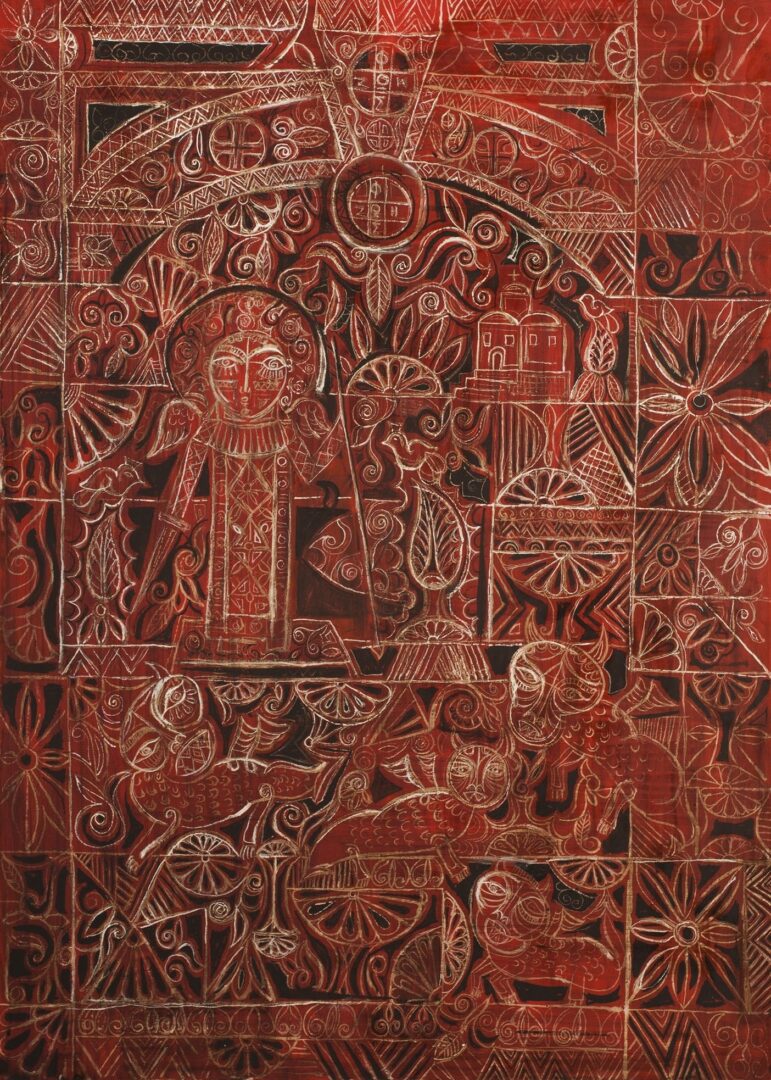
What is it that you wish to highlight through your art?
The main theme of my work is what I wish to create. I desire unity.
Your works are dominated by the perpetual struggle between good and evil, featuring angels, devils, dragons… How do you approach these terms?
For many years now, my art has focused on the battle between good and evil, or, rather, the victory of good against evil. In a way, I wish to highlight the triumph over our passions, or, at least, the way we tame them. The latter is central in different cultures in human history. This process leads to the enlightenment and elevation of every human being to a higher spiritual entity, to a higher spiritual level.

How does your relationship with your artworks evolve over time?
In my humble effort, each of my artworks is a blueprint for the next one. As the process evolves, they all work together to function as a whole. There have been times that I considered my last one the best and that led me to make changes in the previous ones. The whole project is complete when I can add to the agony, but cannot add to the calm and sobriety. A true artist is one who demonstrates love for the works of his fellow artists and not for his own. Besides, when you love your works too much, you might end up strangling them or being strangled by them.
*Interview by Dora Trogadi
TAGS: ARTS

